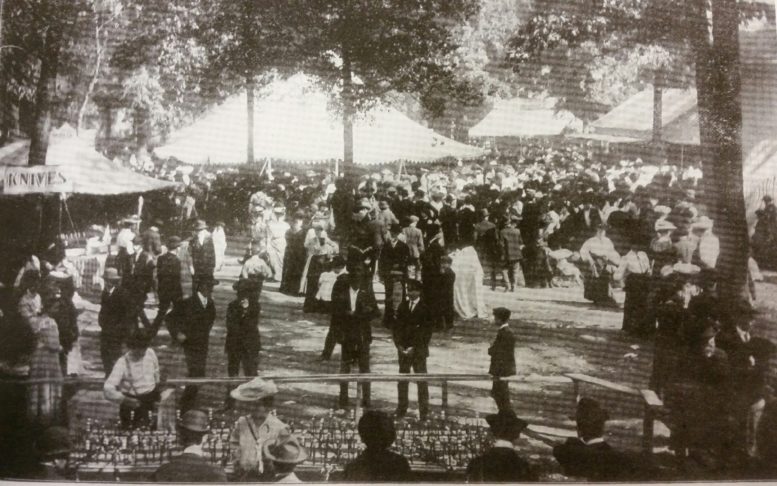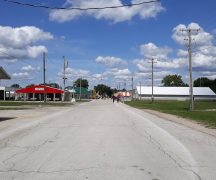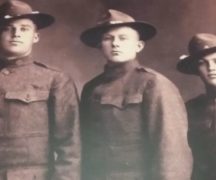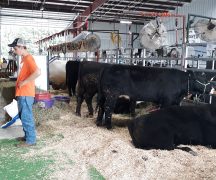By JAN LARSON McLAUGHLIN
BG Independent News
The Wood County Fair’s history is steeped in far more than prize steers, skillfully stitched quilts and homemade pies.
Those county residents who think the fair has a bland story to tell, may not know about the cholera outbreak that drastically cut attendance in 1854, the hoochie-coochie girls who stirred up trouble in 1896, or the ostrich races in 1962.
Or that in 1883, fairgoers could purchase side tickets to watch the hanging of Carl Bach, who murdered his wife with a corn knife.
And few probably realize the pressure from the H.J. Heinz Co. in the late 1920s to change the fair date so it didn’t conflict with tomato harvest, because the company couldn’t find enough employees to show up at work to bottle the ketchup during the fair.
According to records compiled by Dick Martin and the county genealogical society, since 1851 the Wood County Fair has jumped around from Bowling Green, to Perrysburg, to Portage, to Tontogany, and back again many times. In fact, for a series of years it was held in two towns because of warring fair factions.
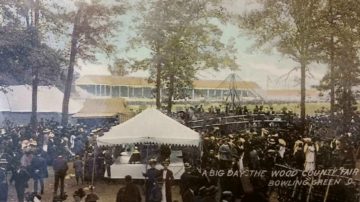
This year’s Wood County Fair begins Monday, and bears little resemblance to the first county fairs, except for the ability to attract people from around the county to reconnect with friends and recognize agricultural prowess in the region.
The county fair was, for many, the event of the year. It attracted families in their best clothing for food, music and competitions. Some records show that the Wood County Fair had the top attendance of any county fairs in the state.
Old black and white photos show lines of horses and buggies, then later lines of old automobiles, in the area that is now the Country Club golf course.
The fairs have always given businesses an opportunity to advertise their products. Back in 1920, there was a booth called the “Wife Saving Station,” which boasted the latest in home plumbing equipment.
The official program for the 1906 Wood County Fair included advertisements for businesses offering horseshoeing, the best men’s shoes in the city for $3.50, rooms at the Hotel Millikin for $2 a day, and a hatter who could make old hats look like new.
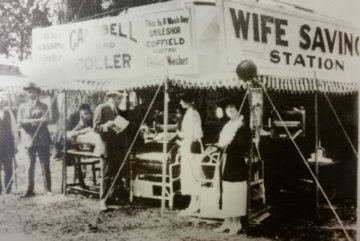
‘Wife Saving Station’ at the fair showed latest home plumbing inventions.
In 1908, the papers talked of animal shows featuring trained lions, tigers, leopards, panthers, pumas, bears, monkey and baboons, and exhibits only found at big expositions and large fairs. And the concessions, well, they promised to be “a heap doing.”
In 1928, harness racing and live music had people packed in like sardines, the papers reported. Local fair officials bragged that the Wood County Fair was far better than the Ohio State Fair.
This year’s fair is offering outhouse races, but there were also some unusual races throughout the history of the fair. For example, back in 1962, there were ostrich races with the large birds pulling sulkies like those used by horse trotters. The sulkies were ridden by local drivers, who likely had no experience being pulled around by ostriches before.
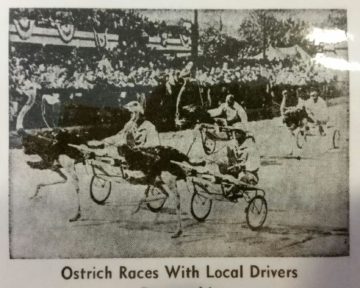
Photo of ostrich races at the fair
Newspaper articles from early fairs indicated some concerns about the lively – even immoral – nature of the events. In 1896, it was reported that “The hooche-kooche dancers have been amusing young men at Fostoria by their licentious dances might be a drawing card that would suit some who book attractions for our county fair.”
The fair apparently brought out the worse in both genders. “A couple of well-dressed married women residing near town engaged in a lively fight just outside the fairgrounds this afternoon. One used her fist and the other a parasol. The husband of the most pugilistic one stood by and watched the old woman do the other one up. Some very choice language was used.”
Stories later in the week did not get any better. “The police were kept busy this afternoon taking in suspects that were captured at the fairgrounds. There are an even dozen in the city lockup, but as yet none have given their names. Four are said to have attempted to pick pockets. The remainder are drunks and gamblers.”
“Never before in the history of the county was such a fair held here. It amounted to nothing more or less than a show of immorality. There were skin games of all sorts and an army of crooks, thieves and pickpockets that preyed upon the public.”
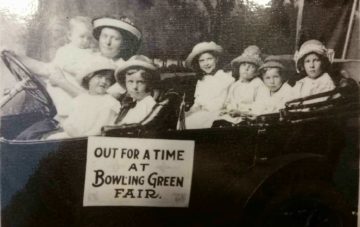
“The honest farmer, his good wife and his daughter were publicly insulted and keenly they felt it. Upon the grounds were shows whose proprietors had no hesitation in telling the public that they were immoral and that women could not be admitted. In front of one of these places a woman was exhibited with nothing over her shoulders or upper portion of her body but a piece of cheese cloth, which was thrown loosely over her head and could be seen through several feet away.
“The ‘coochie coochie’ dancers were also decidedly immoral and not only men visited them, but boys scarcely in their teens who had the necessary dime. Seeds of immorality were sown that will bear noxious fruit in the minds of the young.”
“In the future the farmers will see that there is no repetition of this year’s immoral fair.”
And that was that.
According to information gathered by the Wood County Genealogical Society, this is the timeline of the Wood County Fair:
1851 – A group of citizens from the various townships in Wood County met on June 9 to form the Wood County Agricultural Society. The first Wood County Fair was held Oct. 15 and 16 in a grove of trees on the north side of Wooster Street near Church Street in Bowling Green.
1852-53 – The fair moved to Perrysburg in 1852, then back to Bowling Green in 1853.
1854-55 – The fair was held in Portage (also called Portageville) but due to a cholera outbreak in 1854, along with the presence of chills, fever and ague in 1855, attendance was small both years.
1856-58 – The fair returned to Bowling Green, though the exact location is unknown. But the folks in Portage were not happy about the fair leaving their town.
1859 – Portage wanted the fair back, so they started their own agricultural society, and had the fair in Sargeant’s Grove.
1860-65 – The fair returned to Perrysburg in 1860 and probably remained there through the Civil War years. It’s possible the Civil War may have brought a temporary halt to the county fair, because there is little reference to the fair that can be found.
1866-85 – The Wood County Agricultural Society purchased land near Tontogany in 1866 and conducted a successful fair at that location through 1885. However, a county fair in Tontogany did not sit well with Bowling Green townspeople and those in the southern half of the county.
1881-82 – A competing private organization known as the Wood County Fair Company was organized on May 2, 1881. In November of 1881, the company purchased land in Bowling Green (now City Park) for a fairgrounds. The first fair at this location has held in 1882.
1882-85 – There were actually two Wood County Fairs – one conducted by the Wood County Agricultural Society in Tontogany and the other by the Wood County Fair Company in Bowling Green.
1883 – Carl Bach, a Milton Township farmer convicted of murdering his wife, was hung at a gallows built behind the courthouse during the 1883 fair in Bowling Green. This was not considered a fair activity. However, it was held during the fair and tickets were sold to the hanging.
1886-1927 – The Wood County Agricultural Society and the Wood County Fair Company joined forces to conduct one county fair at the Bowling Green fairgrounds in the present-day City Park. The fair had a very successful run and at times was considered to be the largest or second largest in the state.
Mid to late 1920s – A weakening farm economy, a series of years with bad weather, pressure by the Heinz company to change the fair date due to the tomato harvest, and a desire to move the fair from a private organization to a public funded entity were all factors in pointing toward the demise of the Wood County Fair. After the 1926 fair, there were questions if the fair would continue.
1927 – In May it was decided the fair would be held yet another year, however, the night before the fair was to open, a fire destroyed one of the largest buildings on the fairgrounds, a huge horse barn located behind the grandstand. Although the fair went on as planned, that was pointed to as the final blow which ended the fair.
1927-28 – Following the 1927 fair, Wood County voters were asked by the Wood County Commissioners to pass a levy to purchase the fairgrounds for $25,000. It was soundly defeated, 5 to 1. The following year, the fairgrounds land was offered to the city of Bowling Green. Bowling Green voters passed a $25,000 bond issue and purchased the 63 acres for a city park. Many of the fair buildings were sold to local farmers and dismantled. Several of the original fair buildings remain in City Park, including Needle Hall.
1928-50 – No official Wood County Fair was held for 23 years, although several tomato and other fair-type festivals were held. In 1948, a Wood County Harvest Festival was begun at the BG City Park. While previous festivals were primarily for BG residents, the harvest festivals from 1948 to 1950 had a countywide focus like a county fair.
1950-51 – In October 1950, a group of county citizens met to form the new Wood County Agricultural Society and the first revived Wood County Fair was held in 1951 in BG City Park.
1952 – Wood County Agricultural Society purchased 30 acres of land on the southeast corner of Poe and Haskins roads. The fair was held at this location (now the fair parking lot) and city park.
1953 – Wood County Ag Society and the Wood County Commissioners purchased 38 acres north of Poe Road, between Brim and Haskins roads. In addition, the Ag Society sold off 9.5 acres (now Ranch Court) to raise money for debt reduction and to build a grandstand. The 1953 fair was held on both sides of Poe Road.
1954 to present – Wood County Fair was held at its present location with additional property purchased to the north and many new buildings added. A major building program was undertaken in 1973 when the Junior Fair Building and five barns were built.

